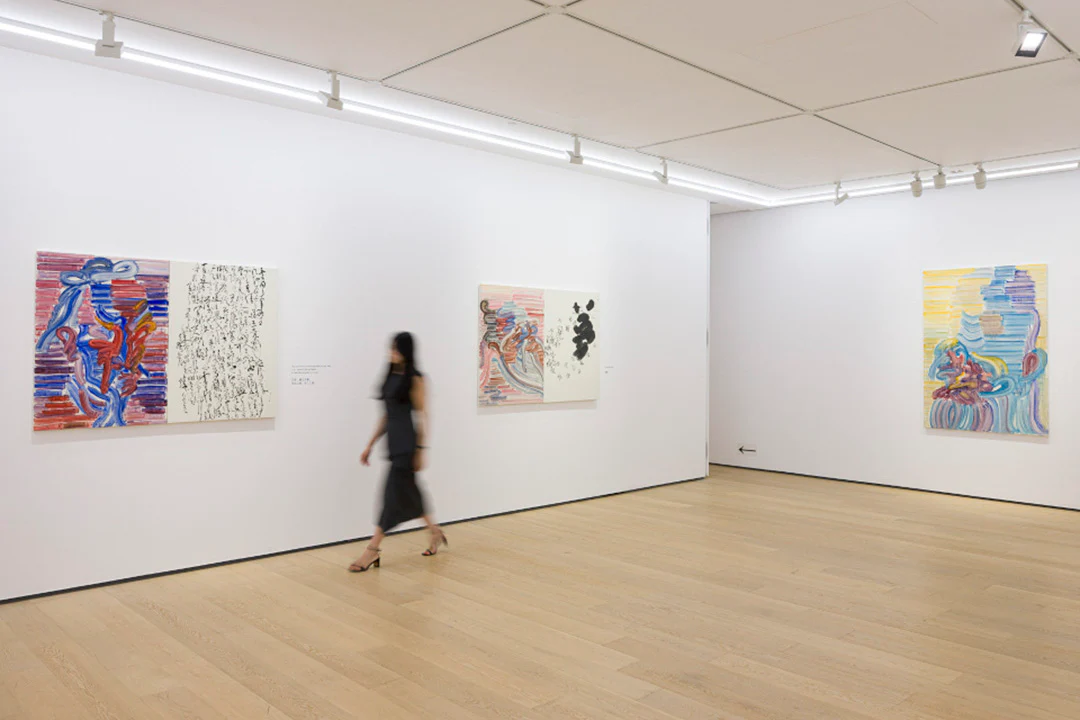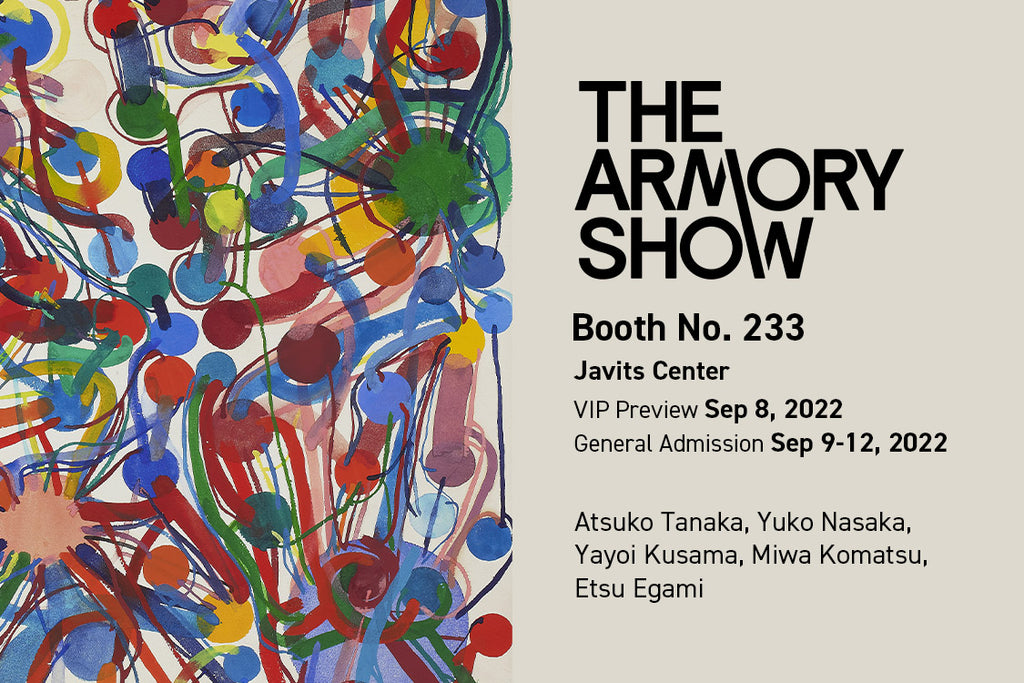ARTICLES
The Universal Philosophy Enticed by Etsu Egami | Etsu Egami × JY Exhibition "The Philosophers"
2023.03.15
INTERVIEW

Whitestone Gallery Hong Kong / H Queen's is holding a collaborative exhibition entitled "The Philosophers" by artists Etsu Egami and JY. Egami is a contemporary artist who seeks to explore and rethink the possibilities of communication gained through cross-cultural experiences, examining them through various academic fields such as the origin of language.
This exhibition presents a series of portraits by Egami that feature bold and plentiful brushstrokes, as well vivid and robust colors, depicting the ideas of ancient Chinese philosophers. In conjunction with the portraits, JY's calligraphic works of classical Chinese proverbs are also presented. In this interview, we ask Egami about this exhibition, which features a harmony between paintings and calligraphy.

Etsu Egami
A Journey into Reading Brought About by the Pandemic

The exhibition view
ー Firstly, tell us about the theme of this exhibition.
Egami: This exhibition is about the ancient Chinese philosophers of the Hundred Schools of Thought. The isolation of the global pandemic gave me more opportunities to read, and for my "Star Time" exhibition at the Ginza Six Tsutaya Atrium in 2021, I presented a series of portraits that depicted modern literary masters. It was during this time that I got to read Shibusawa Eiichi's "The Analects and the Abacus". The "Analects" in the title refers to the compilation of sayings by Confucius that has become the central text of Confucianism. It was this book that got me interested in China's Spring and Autumn Warring States Period, and I began to do more research on it.
The Chinese philosophers who were born during the turbulent times of the Warring States Period in the 5th century BC had many ideas which offer some kind of message for us today, as we are facing a turning point in history. Through their philosophies, I want to rethink modern society. And, as I was thinking about it, I spontaneously began painting.

Installation view of Etsu Egami's solo exhibition at Whitestone Gallery Singapore (2023). The exhibition's title is taken from the opening of Kamo-no-Chomei's Hojoki: "Incessant is the change of water where the stream glides on calmly: the spray appears over a cataract, yet vanishes without a moment's delay"
ー This exhibition features portraits of ancient Chinese philosophers. How did you go about creating them?

From the exhibition view, Left: Etsu Egami 《Laozi-02》 2023, oil and ink on canvas, 107.5 x 153 cm
Egami: I didn't limit myself to the conventional idea of a portrait. I tried to visualize the ideas of the Hundred Schools of Thought in my own way, and I relived their historical context to create a symbolic representation of each ancient philosopher using my paintbrush. The artworks entitled "Laozi" feature a combination of the portrait I drew and the calligraphy of JY. They are the representative artworks of this exhibition.
Laozi's ideas had a profound influence on the development of Chinese philosophy, and the core of his ideas is simple dialectics. Politically, it advocates "governing by non-action" and "teaching without words". In terms of self-cultivation, it emphasizes the practice of "open mind and solid body" and not competing with others, which is also a core teaching of Taoism.
For the oil painting portraits, I used a combination of cool and warm colors that exude from curved lines. The curved lines are stacked on top of each other, like a peak towering over the background of parallel lines that represent the passage of time. The language of the painting and the ideas of Laozi are in complete harmony, and I made the portrait as if I was reviving Laozi with every brushstroke.

JY
For the calligraphy in the "Laozi-02" artwork, I asked JY to create it in the image of Laozi. Written in the style of Chinese bronze inscription are the words, "The greatest square has no corners; the greatest vessel takes longest to finish; the greatest sound is hard to hear; the greatest image has no shape". These words come from the Tao Te Ching text that was unearthed from Mawangdui. Laozi put forward this kind of aesthetic concept in ancient Chinese literary theory, intending to praise natural rather than artificial beauty. By juxtaposing JY's free-flowing calligraphy and the Metonic cycle of nature with my portrait, I believe that it will become an important artwork that creates a new space for thoughts and heralds the birth of a new art form.
What Calligraphy Means to Etsu Egami

Egami Etsu and JY discussing in front of the artwork.
ー This exhibition lets viewers experience a new art form that combines painting and calligraphy. What does calligraphy mean to you?
Egami: That's a very interesting question. When I was dispatched to New York in 2021 as part of the Cultural Affairs Agency Program of Overseas Study for Upcoming Artists, I was invited by the curator of the Museum of Fine Arts, Boston to do a talk. Many American museum curators and art patrons attended my talk, and there was one curator who told me, "Your artworks are neither animation nor ukiyo-e, but they have an Oriental feel. That's because I feel an element of calligraphy in them".
Those words evoked a memory of how I learned calligraphy in my childhood. It never really crossed my mind before, but it may have naturally influenced my artworks in aspects like writing rhythm, physicality, and the "spiritual resonance and vitality" described by Xie He in the "Six Principles of Chinese Painting" back in the 6th century. I want to further explore the relationship between portraits and ideas, images and text, and Oriental calligraphy and Western oil paintings.
Driven by a Pure Desire to Create Art

The exhibition view
ー You have a very active art career, holding exhibitions in art museums and also joining various art fairs and events. How do you create art with such a limited amount of time available?
Egami: I just want to paint so badly, and that strong urge and desire in my heart makes me spontaneously grab my paintbrush and start painting. The breathing sensation, the vibrations on my hand when I paint, and my curiosity to always find something new drive me to paint continuously.

Production
ー Lastly, can you tell us about your plans for the future?
Egami: With my Chinese philosopher series for this exhibition, I want to open a new dimension for my artworks, and I want to delve deeper into how my art can interact with words and calligraphy.
I just finished an exhibition at the Museum of Modern Art, Gunma a few weeks ago, and I've already planned more exhibitions at art museums for the near future. From spring this year, I'm scheduled to travel to Beijing to take a teaching job at Tsinghua University. I also have several overseas institution programs that are currently ongoing. There are a lot of things I want to accomplish, so I want to continue being active in the international art scene, both as a Japanese and an Asian artist.

Installation view of Etsu Egami's solo exhibition at Whitestone Gallery Singapore (2023)
Having done an art museum exhibition and an overseas study program last year, Etsu Egami continues to have a very active and energetic career. She began 2023 with a grand exhibition in Singapore, and now follows it with this new exhibition and with a teaching job scheduled to begin in spring. During the interview, she jokingly confessed how she often declines invitations to do talks or events, yet still finds herself with a jam-packed schedule. Though her rising international fame has made her work increasingly busy, it has also amplified her motivation to create art.
The Etsu Egami and JY collaborative exhibition "The Philosophers" will be held at Whitestone Gallery Hong Kong / H Queen's until April 6th, 2023. You can also view their artworks through the website.

The exhibition view



